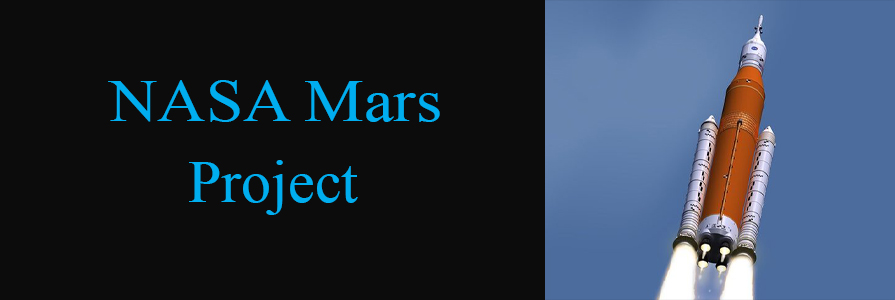
An Overview Of The Artemis Program

The Artemis program is a human space flight program carried out predominately by NASA and U.S. commercial spaceflight companies. International partners such as the European Space Agency (ESA), Japan Aerospace Exploration Agency (JAXA), and the Canadian Space Agency (CSA) are also involved. The Artemis goal is to land "the first woman and the next man" on the Moon, specifically in the lunar south pole region by 2024.
In December 2017, President Trump signed Space Policy Directive 1, a change in national space policy that provided for a U.S. led, integrated program with private sector partners for a human return to the Moon, followed by missions to Mars.
The policy calls for the NASA administrator to "lead an innovative and sustainable program of exploration with commercial and international partners to enable human expansion across the solar system and to bring back to Earth new knowledge and opportunities". The effort intends to more effectively organize government, private industry, and international efforts toward returning humans to the Moon and laying the foundation for eventual human exploration of Mars.
In March 2019, US Vice President Mike Pence announced that NASA's Moon landing goal would be accelerated by four years with a planned landing in 2024. In May 2019, NASA announced that the new program would be named Artemis.
NASA sees Artemis as the next step towards the long-term goal of establishing a sustainable presence on the Moon itself, laying the foundation for the involvement of private companies, and eventually sending humans to Mars.
In Greek Mythology, Artemis was the daughter of Zeus and Leto, and the twin sister of Apollo. (Pictured at the left is a statue of Artemis, located in the Louvre Museum in Paris.) Artemis was worshipped as one of the primary goddesses of childbirth and was the patron of young girls. She was also the Goddess of the Moon. Top
NASA Space Launch System (SLS)
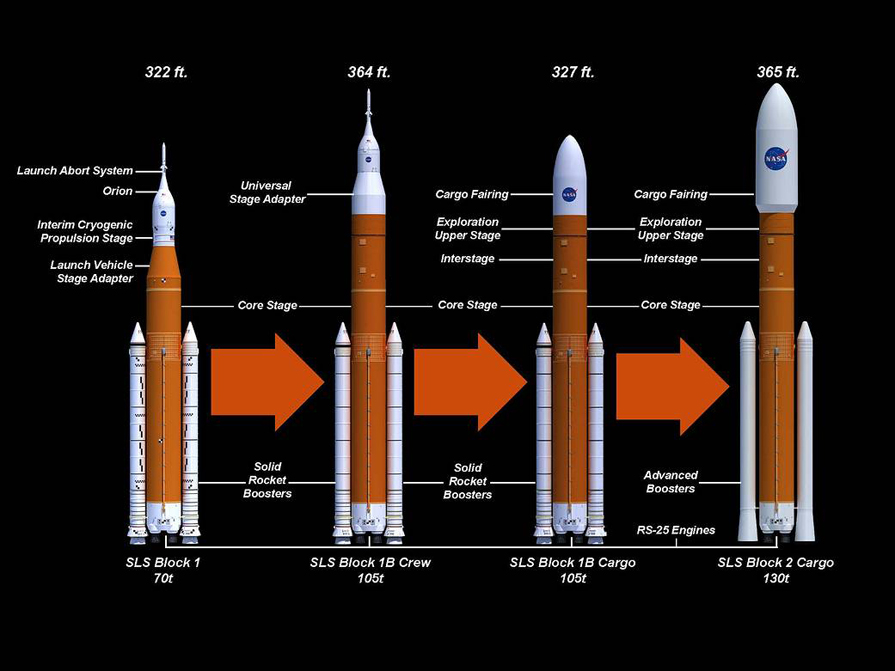
As of December 2019, the Space Launch System (SLS) is a US "super heavy expendable" launch vehicle, which is still under development. It is the primary launch vehicle of NASA's deep space exploration plans. They include the crewed moon flights of the Artemis program and a follow-on human mission to Mars. SLS replaces the previous Ares V launch vehicle of 2005, although it shares a number of technologies and systems. Pictured above are the 4 currently planned flights of the SLS rockets and their loads.
The SLS and the Orion spacecraft (shown below) are critical to NASA’s exploration plans for the Moon and beyond. NASA designed the Space Launch System as the world’s most powerful rocket for safely sending humans on missions into deep space. The Orion human spacecraft is specifically designed to keep humans alive hundreds of thousands of miles from home.
The first mission in 2020, called the SLS Block 1 (see the above large illustration), will test the new spacecraft systems flying together for the first time without a crew. The second flight, called the SLS Block 1B Crew, is targeted for 2022 to take people for a flight test around the Moon. The third and fourth flights of SLS, called the SLS Block 1B Cargo and 2B Cargo systems, will kick-off delivery of major Gateway parts. Gateway is to be a spaceship that will orbit the Moon for a fairly long time, similar to the ISS but smaller. SLS missions will be flown to Gateway about once per year. The SLS third and fourth flights will carry the larger components to the Gateway. Smaller components will most likely be flown to the Gateway by private companies on smaller rockets. Top
A Trans Lunar Injection (TLI)
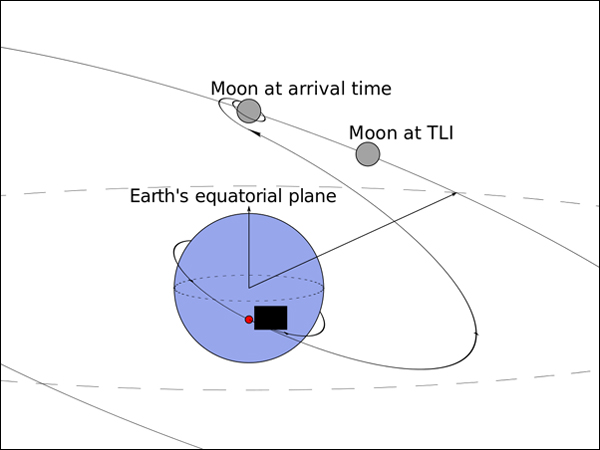
A trans lunar injection (TLI) is a "rocket maneuver" used to set a spacecraft on a trajectory that will cause it to arrive at the Moon. The first space probe to attempt a TLI was the Soviet Union's Luna 1 in January 1959 which was designed to impact the Moon. The burn however didn't go exactly as planned and the spacecraft missed the Moon by more than three times its radius and was sent into an outer space orbit.
The Luna 2 performed the same maneuver more accurately in September 1959 and crashed into the Moon two days later. Even though it crashed, the program was considered a success. In January 1962, the United States launched its first lunar impactor attempt, Ranger 3, which also failed to reach the Moon. This was followed by the first US success, Ranger 4, in April 1962.
A spacecraft performs a TLI to begin a lunar transfer from a low circular orbit around the Earth. See the illustration to the left. A large TLI burn, performed by a rocket engine, increases the spacecraft's velocity and changes its orbit from a circular low Earth orbit to a highly eccentric orbit. The TLI burn is sized and timed so that the spacecraft's path precisely intersects the Moon's orbit. Finally, the spacecraft enters the Moon's sphere of influence and enters a lunar circular orbit. Top
Orion Spacecraft

Orion is a European-US spacecraft intended to carry a crew of four astronauts to destinations beyond low Earth orbit. As of December 2019, Orion is under development and is to be launched on the SLS. Orion is intended to be the main crew vehicle of the Artemis lunar exploration program. In the event of an emergency on the launch pad or during ascent, a Launch Abort System (LAS) will separate the Orion crew module from the launch vehicle using three solid state rockets.
Gateway is a much bigger space system than Orion. It is planned to be a semi-permanent major station in lunar orbit to serve as a solar-powered communications hub, science laboratory, short-term habitation module, and holding area for rovers and other robots. It plays a major role in NASA's Artemis program.
Orion will be used as a tug to deliver major components into the required orbit for Gateway assembly. Orion will be the service module that can attach to and from the Gateway system to perform various tasks. Together, Orion, the Gateway and SLS represent the core of NASA’s sustainable infrastructure for human Moon exploration and a trip to Mars. Top
Gateway - Home To Moon And Mars Missions

NASA is working with its partners to design and develop a spacecraft that will orbit the Moon - the Gateway. This spacecraft will be a temporary home and office for astronauts, just about a five-day, 250,000-mile commute from Earth. The Gateway will have living quarters, laboratories for science and research, docking ports (doors) for visiting spacecraft, and more. It will provide NASA and its partners access to more of the lunar surface than ever before, supporting both human and robotic missions.
Gateway will be comparatively small – a 75-ton assembly, (the Space Station is 450 tons) consisting of just one or two habitable modules, each roughly the size of a school bus, plus a snap-on module for power and propulsion and two others that would serve as an air lock for spacewalking astronauts and a docking port for incoming vehicles.
NASA is currently (January, 2020) working on the Gateway as seen in the illustration above. The first major part will provide power and propulsion for the spaceship, and is targeted to launch on a private rocket in 2022. After it reaches orbit, and test-drives its power and communications, NASA will launch four astronauts on an SLS and Orion mission carrying two new sections that will add a small living space and initial science and operational capabilities. Each year after that, astronauts will travel to the Gateway with new parts until it is fully assembled, currently targeted for 2026.
The Gateway will be a home base for astronaut expeditions on the Moon, and future "human missions" to Mars. Even before our first trip to Mars, astronauts will use the Gateway to train for life far away from Earth, and will use it to practice moving a spaceship into different orbits in deep space.
NASA plans to build the Gateway with just five or six rocket launches (compared to the 34 launches it took to build the Space Station). Astronauts will visit the Gateway at least once per year, but they won’t stay year-round like crew aboard the International Space Station The Gateway is much smaller. Its interior is about the size of a studio apartment, whereas the space station is larger than a six-bedroom house.
Once docked, astronauts can live and work aboard the spaceship for up to three months at a time, conduct science experiments, and take trips to the surface of the Moon. Even without any crew present, cutting-edge robotics and computers will operate experiments inside and outside the spaceship automatically returning data back to Earth. Top
A Stepping Stone to Mars
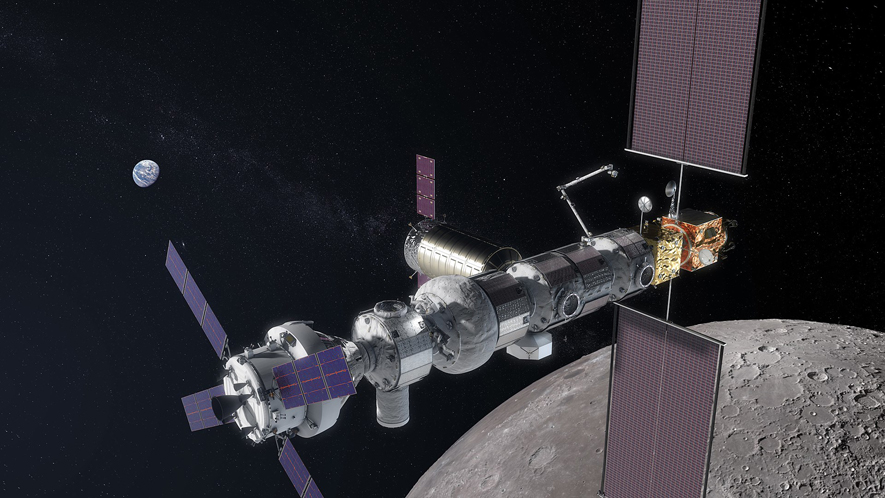
Exploration of the Moon and Mars is intertwined. The Moon provides an opportunity to test new tools, instruments and equipment that could be used on Mars, including human habitats, life support systems, and technologies that could help us build self-sustaining outposts away from Earth. Living on the Gateway (see above illustration) for months at a time, will also allow researchers to understand how the human body responds in a true deep space environment before committing to the years-long journey to Mars. NASA’s Moon mission will lay the groundwork for going to Mars.
“The moon makes sense as a way to practice for Mars,” says John Logsdon, founder of the Space Policy Institute at George Washington University. “Getting experience living off the planet when you’re only days from home is a good idea before you head off to Mars, which is at least eight months away.”
Gateway could provide more than just know-how for Mars; it could also provide resources. The moon is a ready source for water, air and rocket fuel, thanks to ice deposited in its poles. Astronauts could harvest the ice and ferry it up to the Gateway, where some of it could be stored as water and the H2O molecules in the remainder could be broken down into their constituent hydrogen and oxygen parts. Mars-bound astronauts could stop by and pick up supplies they need for their trip, saving the enormous cost of muscling those essentials off the Earth. A second habitation module could also be kept docked to Gateway, which the Mars crew could pick up on their way out to expand their living space for the long trip and drop it off on their way back. Top
Mars - Tough To Visit
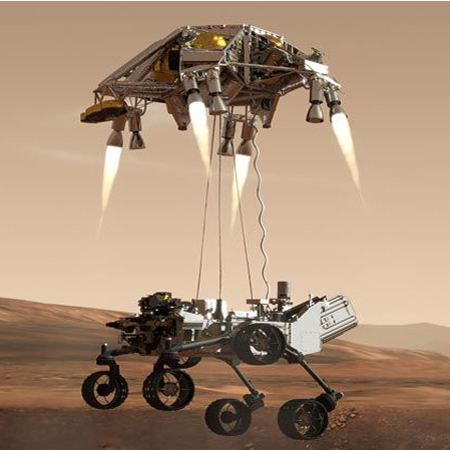
Two out of three missions to land on the red planet have failed. If getting to Mars is hard, landing there is even harder. Here are a few examples.
The Soviet Mars 3 in May 1971, made it to the surface in a controlled landing, even navigating through an intense dust storm on its way down. However, the craft operated for just 20 seconds before falling silent, sending back only one un-interpretable image. Still, it was the first Mars landing success.
Perhaps the most infamous failure was NASA's Mars Climate Orbiter’s destruction in 1999. The issue wasn’t even all that technical: One part of the team used English units such as pounds and feet in the software, while the rest of the team used metric units. The real problem was that no one noticed the discrepancy until the spacecraft shot far too close to the planet, burning up in an atmosphere it was never supposed to enter. It was one of NASA’s most embarrassing mistakes.
In 2003, the European Space Agency successfully piloted Mars Express into orbit around the Red Planet. In December of that year, the orbiter released its lander component, Beagle 2, for a Christmas Day touchdown. The lander went out of radio contact, and was never heard from again. Scientists assumed that the lander had crashed. Then in 2016, researchers looking over Martian satellite photographs found the crash site - which wasn’t a crash at all. It turned out the lander had settled quite gently onto the Martian terrain. Its parachute was still visible. The problem was its solar arrays, one of which didn't unfold correctly. That left the lander unable to send signals back to Earth.
Pictured above is an artist's conception of the landing of the NASA Mars Rover Curiosity on the planet. In the last few hundred feet the Rover is lowered by ropes while the spacecraft holds its position by firing its landing rockets. This approach, called the Sky Crane, has proven to be very successful.
Space engineers are very serious when they say that landing on Mars is hard. It has more gravity than the moon, less atmosphere than Earth to fill parachutes, and it’s far enough away, that all landing maneuvers must be done automatically by autopilot with no help from Earth.